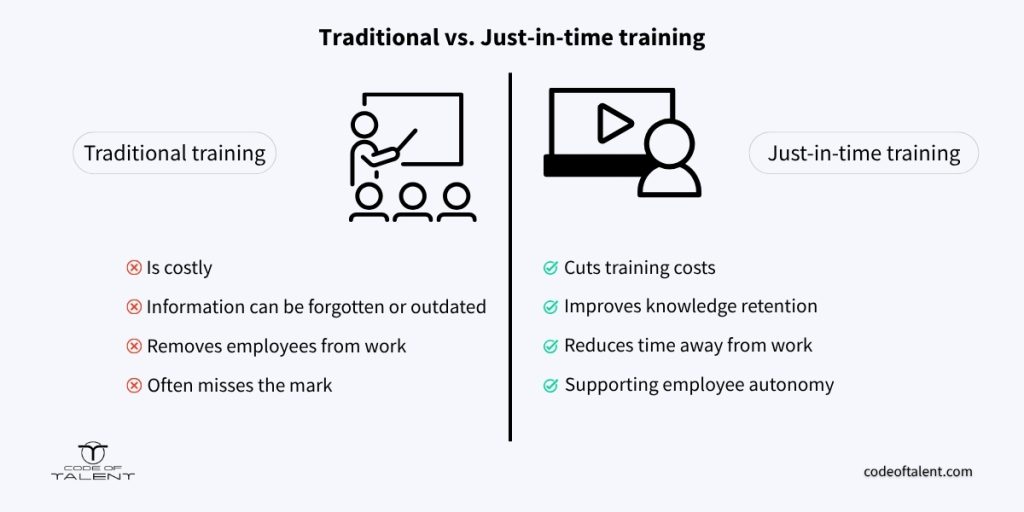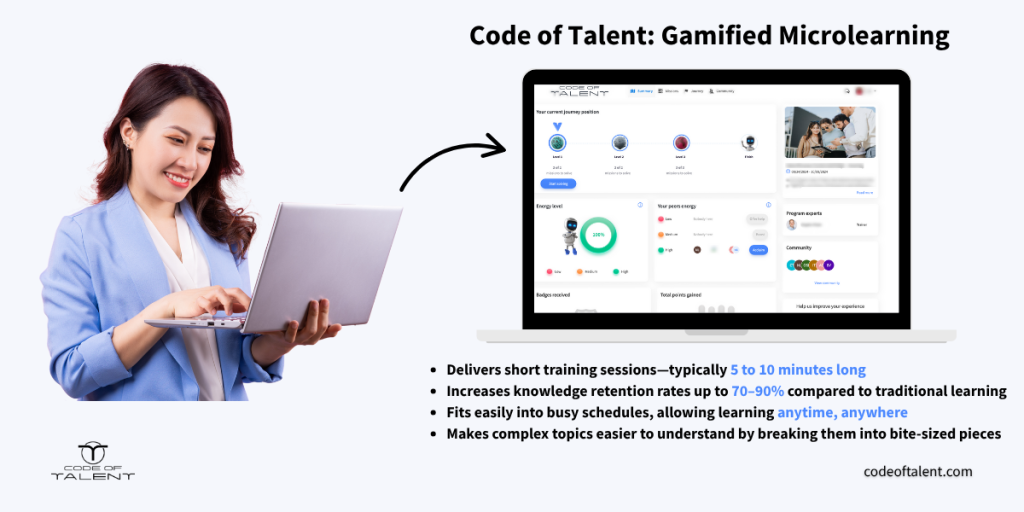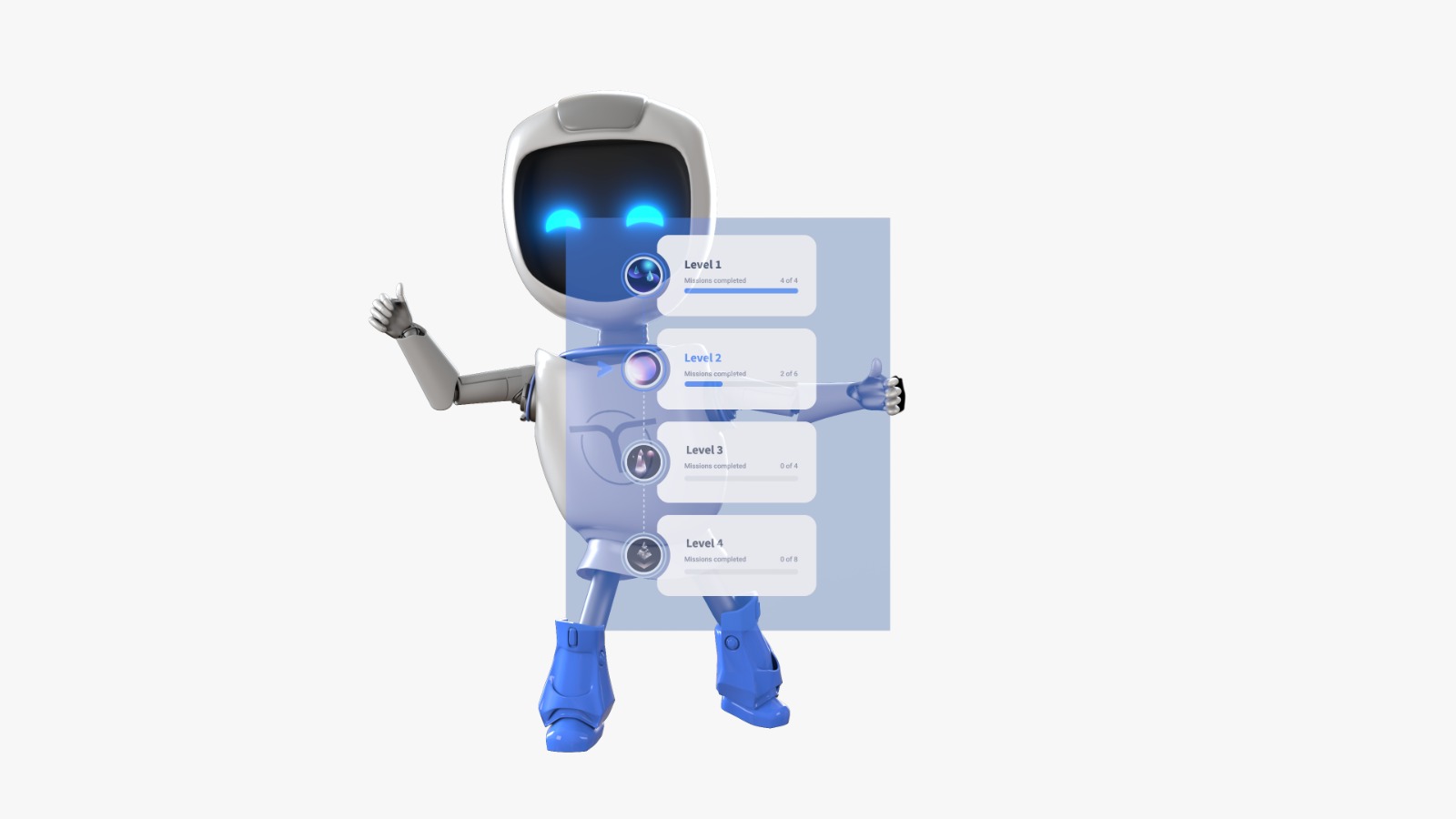You’re a sales rep heading into a client meeting. The product was just updated, but you haven’t had time to review the changes. Instead of digging through PDFs, you open your training app, watch a 90-second video, and you’re ready. That’s the power of just-in-time training: it gives you the right information at the right moment, without interrupting your work.
This approach is more than just convenient, it’s what employees want from their learning programs. A recent report by Lorman found that 85% of employees want training that fits their schedule. Yet many companies still rely on rigid systems. This often leads to training that often arrives too early to be useful, or far too late.
This article unpacks the what, why, and how of just-in-time training, and why it’s quickly becoming the most effective way to support modern employees.
What Is Just-in-Time Training?
At its heart, just-in-time training is about relevance and timing: providing people with exactly the knowledge they need, at the exact moment they need it, without the conventional restrictions of scheduled training.
The Philosophy Behind Just-in-Time Training: From Manufacturing to Learning
The concept of “just-in-time” was first pioneered by Toyota as part of its now-famous Toyota Production System. In post-war Japan, resource scarcity forced manufacturers to rethink efficiency. Toyota’s solution was radical: instead of stockpiling large quantities of materials and components, they would only produce or deliver parts right when they were needed in the assembly process.
This eliminated waste, reduced costs, and increased flexibility. The methodology emphasized lean operations: doing more with less by improving timing, flow, and access to resources.
When adapted to training, this philosophy remains the same. Instead of front-loading employees with information they may not use for months (or ever), just-in-time learning provides content when a task demands it. The result is:
- Greater efficiency
- Better memory retention
- Fewer wasted hours.
What Just-in-Time Training Looks Like in Practice
In a learning context, just-in-time training typically lives inside the flow of work. Think of:
- A short training video inside a customer service tool, showing how to handle a refund.
- A tooltip in a dashboard that explains a new feature when hovered over.
- A searchable knowledge base with quick answers during tasks.
- AI chat support that provides step-by-step guidance in real time.
- A platform that delivers training in short missions
Instead of redirecting employees to long courses or multi-day workshops, these tools offer immediate, focused, and accessible information when learners want and need to access it.
Benefits of the Just-in-Time Training Method
The shift toward just-in-time training is a fundamental improvement in how people learn at work.

Traditional training methods:
- Can be costly
- Often miss the mark
- Remove employees from productive work
- Deliver information that’s quickly forgotten or even outdated.
On the other hand, research in ScienceDirect also highlights that some of the most impactful learning is informal, social, and experiential, the kind of learning that just-in-time training supports by:
- Improving knowledge retention: Just-in-time training reduces cognitive overload and helps learners remember and apply knowledge better over time.
- Supporting employee autonomy and problem solving: It encourages workers to find solutions on their own without waiting for formal sessions or help from managers, which promotes proactive problem-solving.
- Reducing time away from work: Employees spend less time away from their tasks to attend lengthy training sessions. Instead, learning happens within the workflow, which helps maintain productivity and keeps work on track.
- Cutting training costs: Focusing only on the necessary information helps organizations avoid wasting time and resources on outdated or unnecessary training, leading to significant savings.
Just-in-Time Training Examples in Action
From a quick “how-to” video before a client call to an AI chatbot answering a complex technical question on the spot, just-in-time training comes in many formats.
Microlearning
A key method of delivering just-in-time training is microlearning: short, focused lessons that employees can access anytime, anywhere.
According to Software Advice, 58% of employees prefer learning content that’s broken into short segments. These micro-lessons might cover one skill or answer one question, lasting no more than a few minutes. They’re especially effective because they don’t overload the brain and allow learners to act immediately on what they’ve learned.
- Example: A short module on how to offer feedback on colleagues’ work.
- Format: Text, quizzes, audio, or mini-scenarios.
Video-Based Learning
Short-form videos are another powerful way to support just-in-time learning. Whether it’s a two-minute product training or a 60-second refresher on how to submit an invoice, videos are the fastest and most effective method of learning with today’s distracted workforce.
In fact, a SurveyMonkey study found that 65% of employees prefer to learn by watching videos. LMS systems, internal platforms, or mobile apps easily incorporate videos into training, making them instantly accessible.
- Example: A tutorial on understanding standard GDPR practices.
- Format: Screen recordings, voice-over demos, or animations.
Tooltips and In-App Guidance
Tooltips and in-app guidance deliver training directly within the workflow, helping employees learn as they work. These brief messages or pop-ups appear when a user interacts with a new feature, offering immediate explanations or step-by-step instructions.
- Example: A message that explains a new CRM feature when it’s first used.
- Format: Tooltips, checklists, or interactive pop-ups.
Searchable Knowledge Bases
Searchable knowledge bases are centralized resources where employees can quickly find answers and instructions on demand. These platforms often include articles, FAQs, videos, and step-by-step guides.
- Example: Searching “submit expense report” brings up a simple step-by-step guide.
- Format: Web-based wiki or internal help site.
AI-Powered Chatbots
AI-powered chatbots offer interactive, real-time guidance by answering questions and providing step-by-step help. Instead of searching through manuals or waiting for help, employees can ask the chatbot for immediate support. Many apps and platforms have integrated AI chatbots into their framework over the years, making it a standard practice.
- Example: Asking a chatbot, “How do I reset my password?”
- Format: Conversational AI with links to articles, forms, or videos.
Mobile Learning Apps
Mobile learning apps deliver training directly to smartphones and tablets, making it easy for employees to access on demand, which is especially useful for remote or field workers. These apps often feature quick videos, quizzes, checklists, and guides tailored for on-the-go learning.
- Example: A technician pulls up a 90-second safety refresher on-site.
- Format: Mobile-friendly videos, quizzes, PDFs, or checklists.
Contextual Learning in Workflow Tools
Contextual learning embeds training materials directly within the software tools employees use every day, like CRMs or project management platforms.
- Example: A quick guide appears in Trello when using a new template.
- Format: Slide-ins, links, embedded videos, or micro-courses.
How to Implement Just-in-Time Learning in Your Organization
Implementing just-in-time training requires a strategic integration plan that should work on 4 pillars: analyze, contextualize, test, and monitor.
Here’s how to make that happen:
1. Diagnose Training Pain Points
Begin by auditing your current training approach:
- Where are employees getting stuck?
- What questions come up repeatedly?
- Where does performance lag due to knowledge or skills gaps?
Identify the high-friction moments in daily workflows, as these are the best candidates for just-in-time interventions.
2. Choose Context-Aware Delivery Methods
Match the delivery format to the work environment:
- Microlearning works well for ongoing training that supports skills and procedures used regularly over time (compliance, upskilling, etc.).
- In-app tooltips or popups help employees navigate complex software.
- AI-based assistants offer real-time answers in customer service or IT support.
The goal isn’t to cover everything. In fact, choosing one platform should be an ideal strategy so that the employees are not overwhelmed.
3. Start Small and Test for Impact
Rather than rolling out a company-wide initiative immediately, choose a single team or department to pilot your approach.
For example:
- Equip a sales team with 90-second feature videos embedded in their CRM
- Add searchable SOPs to a frontline operations dashboard
- Use a chatbot to answer HR policy questions instantly
- Use a microlearning platform to onboard frontline employees
Gather feedback, track usage, and measure outcomes like reduced task time or increased first-time accuracy.
4. Use Data to Iterate and Expand
Successful just-in-time training is never one-and-done. Use analytics to see which assets are used, skipped, or outdated. Pair usage data with employee surveys to identify new needs.
Over time, this feedback loop helps fine-tune your content.
Common Mistakes to Avoid with Just-In-Time Training
While the benefits are clear, just-in-time training needs thoughtful design to work well.
Overloading Content
A common misstep is trying to cram too much information into a single lesson. According to ThriveMyWay, 65% of employees already feel overwhelmed by their current training. Keep lessons focused on one task or concept, not a cluster of ideas.
This is why microlearning is one of the best methods of just-in-time training: it delivers the right amount of information in separated sessions.
Ignoring Accessibility
Effective training needs to be inclusive. Today’s workforce is more diverse than ever, with people of different ages, backgrounds, learning styles, and abilities. Many employees also work in hybrid or fully remote settings, which adds complexity to how training is delivered and accessed. Just-in-time training, by its very nature, promotes accessibility.
That means:
- Providing captions for video content
- Ensuring tools are screen-reader friendly
- Offering alternative formats for those with different learning preferences
Letting Content Go Stale
Nothing undercuts trust faster than outdated information. Here’s how to ensure that training content stays relevant with just-in-time training:
- Assign clear owners: Give each training module a dedicated person responsible for updates.
- Schedule regular reviews: Set reminders to check and refresh content every few months.
- Collect feedback: Let employees report outdated or confusing info.
- Use version control: Keep track of changes to maintain consistency.
Automate reminders: Use tools that prompt updates to avoid stale content.
Leveraging the Right Platform for Just-in-Time Learning
Code of Talent is purpose-built to help organizations deploy just-in-time training effectively, without complexity.
Its platform allows L&D teams to:
- Design microlearning pathways tailored to specific job roles
- Embed content into real workflows, including desktop and mobile
- Use AI-driven personalization to adapt training to each team’s and department’s needs
- Get actionable analytics on content usage, completion rates, and performance impact
Because Code of Talent supports real-time updates, it also helps organizations avoid the trap of outdated or overloaded content. It brings agility to learning so employees are never stuck waiting for answers.

Conclusion
Just-in-time training is no longer a niche strategy, but a necessity for modern teams. When learning happens at the moment of need, it becomes more relevant and more effective.
From reducing training costs to improving employee performance, just-in-time training offers a smarter way to build knowledge and confidence on the job.
With tools like Code of Talent, organizations can deliver personalized, scalable training that supports employees in real time, without ever pulling them out of their workflow.
Start a free trial today and build your own just-in-time training program from scratch!
Cover photo: Freepik





